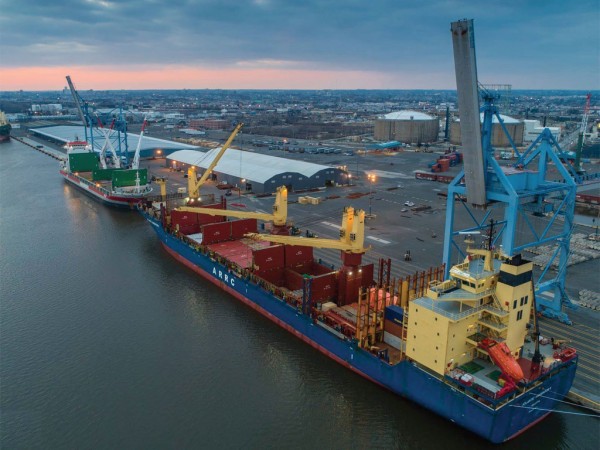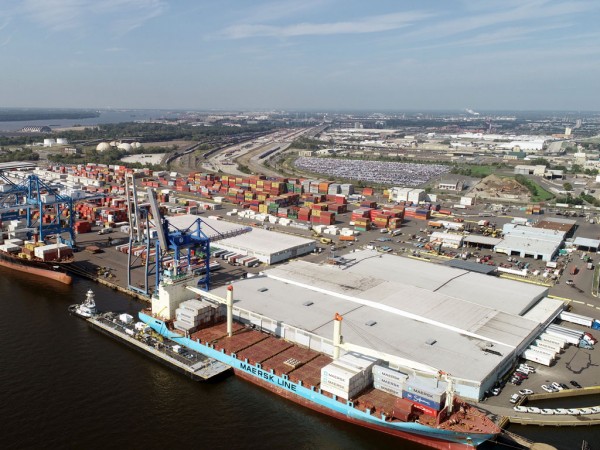With the more-than-quarter-century-long effort to deepen its river channel nearing completion, new super-post-Panamax cranes continuing to arrive, terminal enhancements advancing and additional carrier services calling, the Port of Philadelphia is perfectly positioned to keep breaking cargo records.
Sean Mahoney, longtime director of marketing of the Philadelphia Regional Port Authority, rebranded in mid-2017 as PhilaPort, told AJOT he believes the good times are just starting to roll.

“We’ll be ready to rock and roll and, as competing ports like to say, be big-ship-ready,” Mahoney said of the fast-approaching completion, for which a May 20 celebration is on the PhilaPort calendar.
Cargo already is moving across PhilaPort docks at a record pace.
“Our stats are really terrific this year,” Mahoney said, noting that PhilaPort handled more than 600,000 TEUs of containerized cargo in calendar 2018, up 9 percent from the prior high established the preceding year. “We’ve had double-digit growth or almost-double-digit growth for most of the past decade.”
That equates to a total gain of 166 percent in TEU count over a 10-year span, putting PhilaPort on pace to eclipse the 1 million TEU mark by 10 years from now.
“The trajectory is going exactly as planned,” Mahoney said. “The next 300,000 or 400,000 TEUs we should be able to do without breaking a sweat.”
A good portion of that heightened activity is anticipated to reach well beyond the U.S. Northeast and the 27 million consumers living within a 100-mile radius of Philadelphia.
“We’re making inroads into being able to handle more discretionary cargo,” Mahoney said. “CSX is offering us good intermodal service to and from the Midwest.”
Indeed, much of the cargo that has been arriving over the past years at Philadelphia, including on Mediterranean Shipping Co. vessels each with 12,200-TEU capacity, has been destined for the Midwest, he said.
To efficiently accommodate big ships, PhilaPort has been bolstering its lifting capabilities. The port received its first two super-post-Panamax gantries last May and is slated to get two more such units March 19, to be followed by yet another similar extra-large crane by yearend. That will give PhilaPort’s Packer Avenue Marine Terminal seven ship-to-shore cranes, with five of those being of the super-post-Panamax variety.
The Packer Avenue facility is undergoing $266 million in enhancements thanks to Pennsylvania state funding (including the lion’s share of a 2016 gubernatorial commitment of more than $300 million in bond-backed monies for PhilaPort improvements) and investments of terminal operator Greenwich Terminals, with a further boost from a $25.5 million federal Infrastructure for Rebuilding America grant. Endeavors include wharf fortifications and warehouse replacements.
The 200,000 square feet of new warehousing being built about a quarter of a mile from Packer Avenue docks is buttressed by rapid development of distribution centers for big-box retailers and others in the region extending throughout the Lehigh Valley and South Jersey.

A few new services are in the works, he said, including the port’s latest MSC offering – weekly service bringing citrus from South Africa – set to launch in the spring.
At PhilaPort’s Tioga Marine Terminal, the most recent carrier addition is Atlantic RoRo Carriers Inc., which last summer began calling with multipurpose vessels in ARRC’s Northern Europe and Russia service. The Tioga facility, which, among other attributes, supports Pennsylvania’s log and lumber industry with exports to furniture manufacturers in Asia and elsewhere, also has unveiled a new fumigation facility and is getting an additional 100,000 square feet of warehousing for forest products, which continue to be handled in increasing volumes.
Meanwhile, PhilaPort’s Southport facilities for handling vehicles are undergoing $93 million in enhancements, with most of the terminal having been brought above the 100-year-flood-plain level – which Mahoney said makes it unique among such complexes on the U.S. East Coast.
Dominic O’Brien, who recently was promoted to PhilaPort’s senior marketing manager from senior marketing representative, pointed out to AJOT that raising the terminal elevation is particularly important to shippers of vehicles, commenting, “When those cars are parked and there’s a storm, they want to be confident their cars are going to be in good shape. It’s a real selling point with the auto shippers.”
Also on the auto business front, PhilaPort looks to dedication in May of a new 100,000-square-foot vehicle processing center.
Furthermore, PhilaPort has embarked – permitting in hand – upon design work for additional facility development, including a new 2,000-foot-long berth at the Southport complex.
With all this dynamic activity, PhilaPort is engaging in a public-private partnership to provide specialized training through a workforce development initiative announced in December in conjunction with partners Citizens Bank, the Collegiate Consortium for Workforce and Economic Development and Philadelphia Works, which is the city’s workforce development board.
“One of the great things from all the success we’re having is that we’ve acknowledged that there is a need in Philadelphia for workforce training,” Mahoney said of the efforts to this year open the Citizens Bank Regional Maritime Training Center in South Philadelphia.
“It’s sort of proof positive that all these good things are happening,” he added. “To go along with that success, we’ve got to build a skill-based workforce, and I think that’s a great thing.”
O’Brien interjected, “One of our sell points is that we’re more responsive, with better customer service, and, if you’re going to keep that up, you need well-trained workers.”
Key advantages offered by PhilaPort, according to O’Brien, also include abundance of available equipment, swift turn times and lack of terminal and rail congestion.
“We do not suffer from equipment shortages,” he said. “We have plenty of chassis provided by DCLI and TRAC and there is plenty of drayage capacity.
“Finally, we are reasonable on surcharges,” O’Brien continued.
“For example, there are no terminal or line congestion surcharges, there have been no recent trucking rate increases in our area, and the efficiency of our operations results in minimal demurrage and detention charges.”




